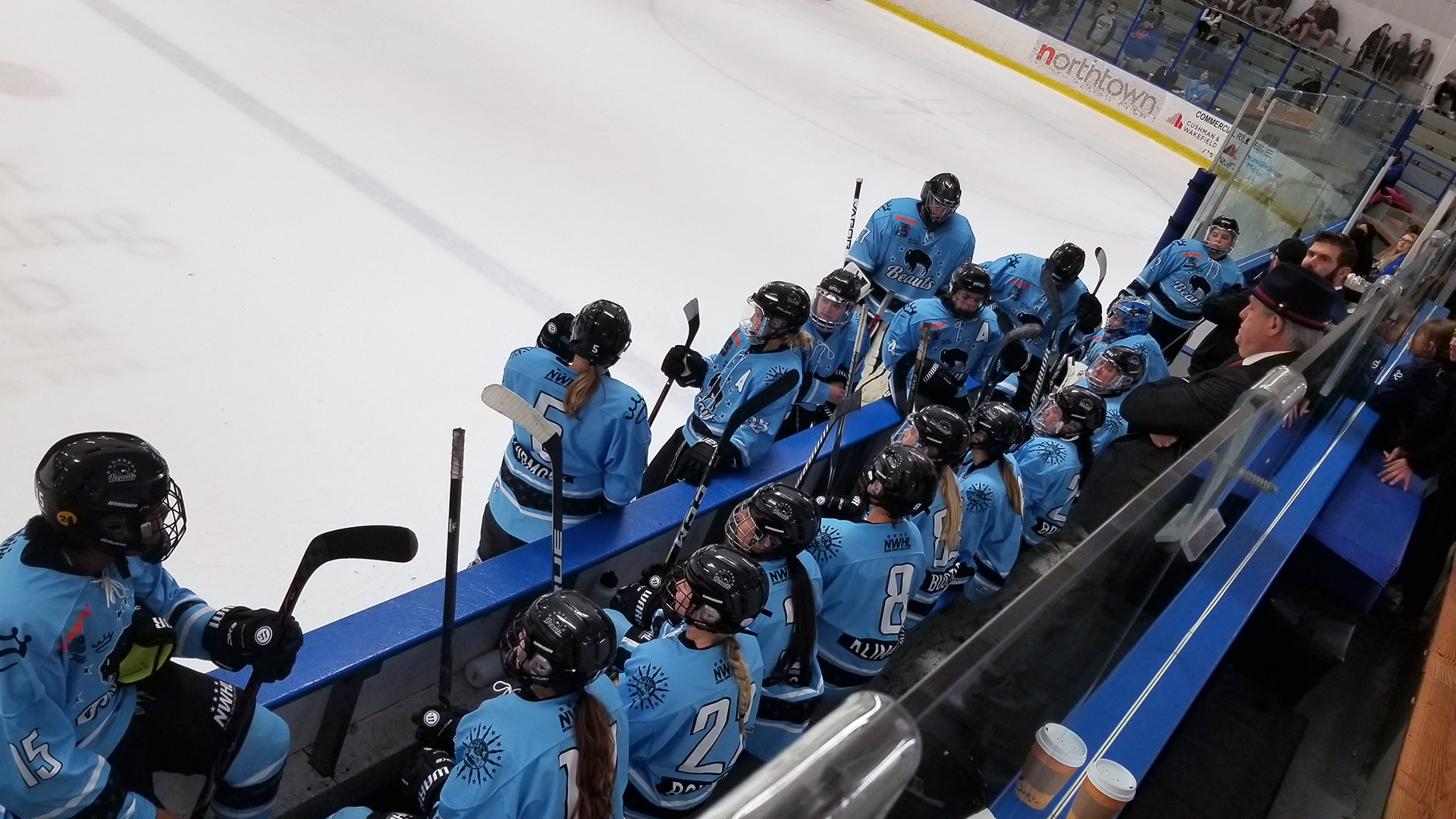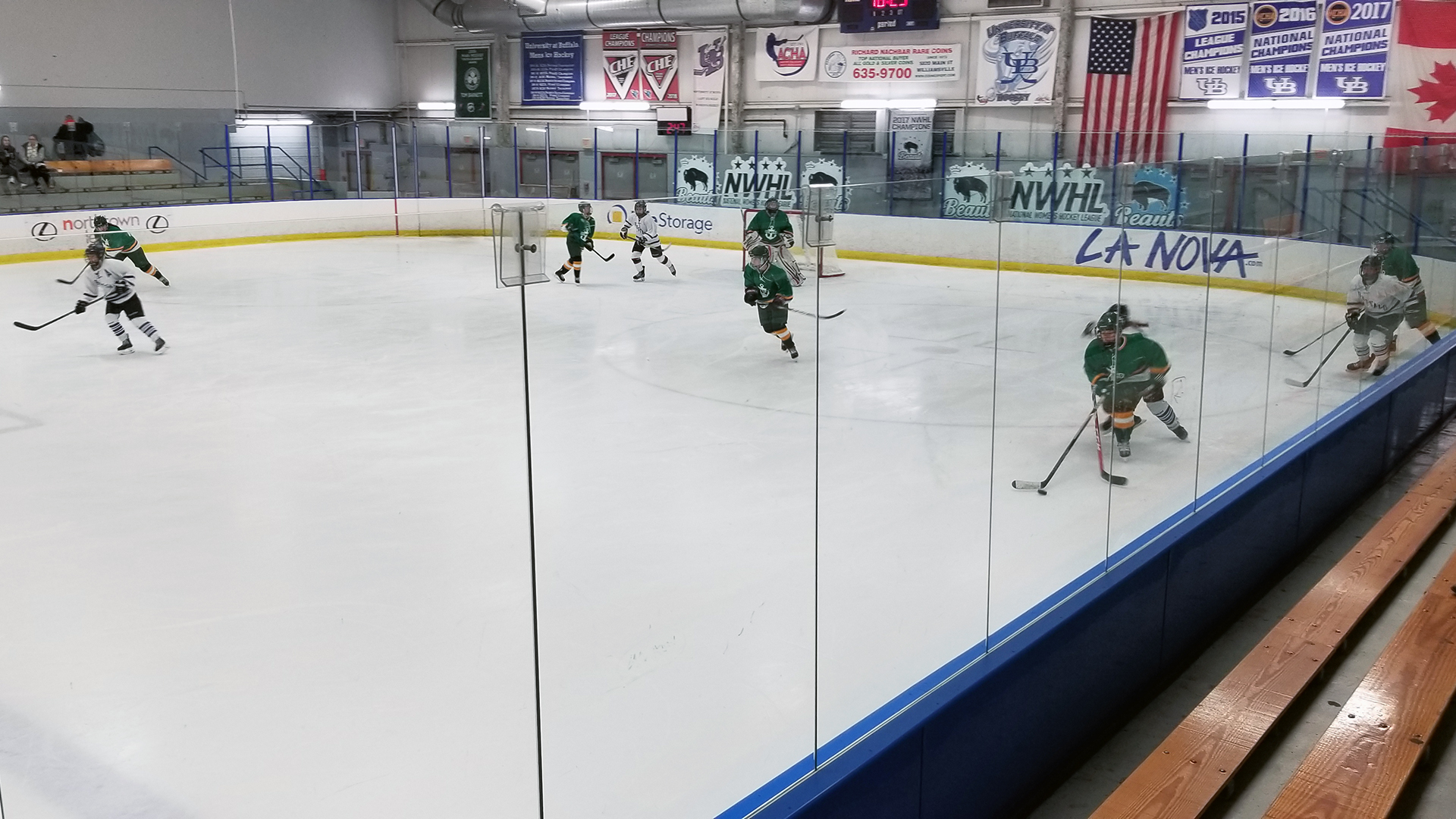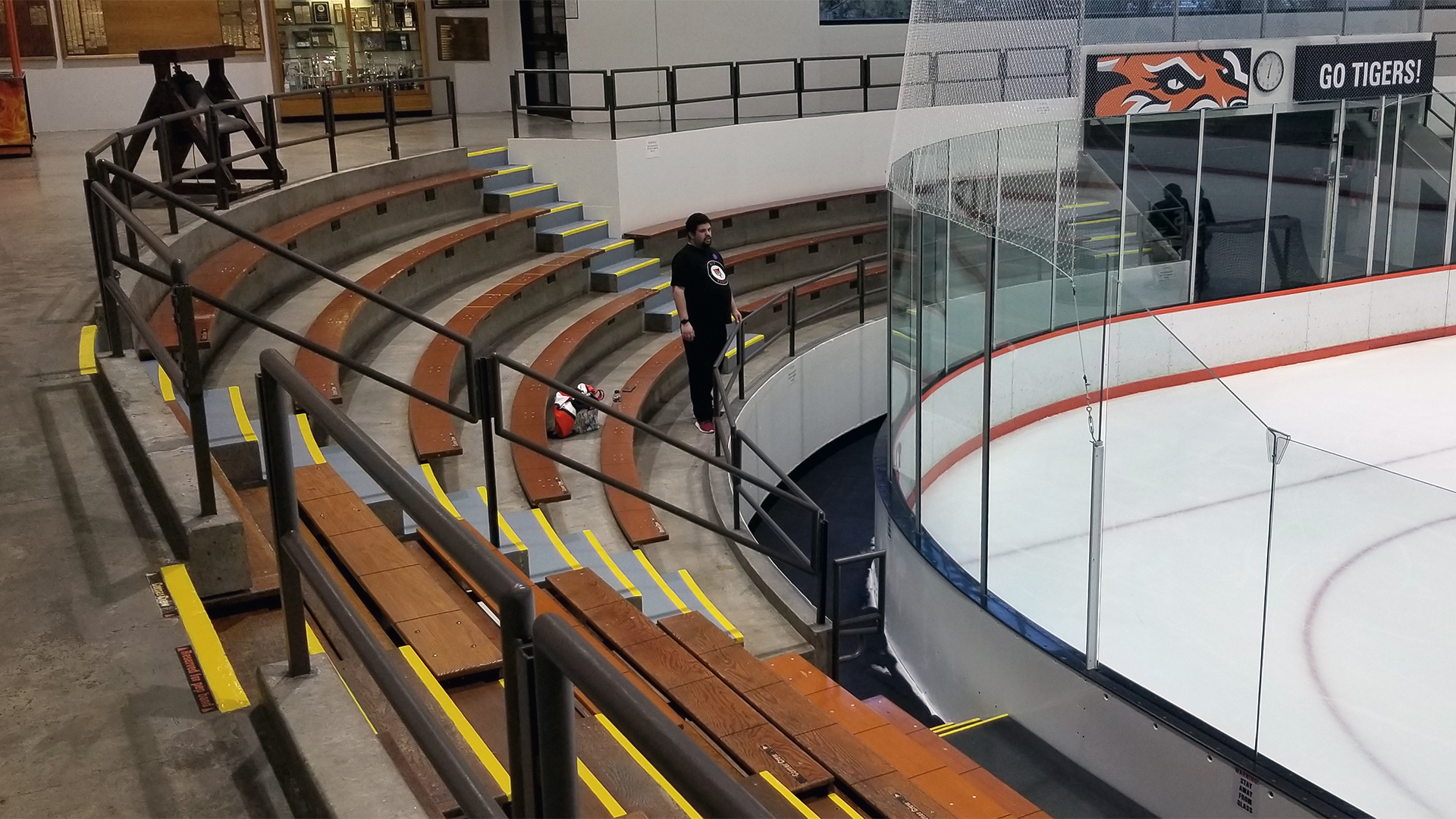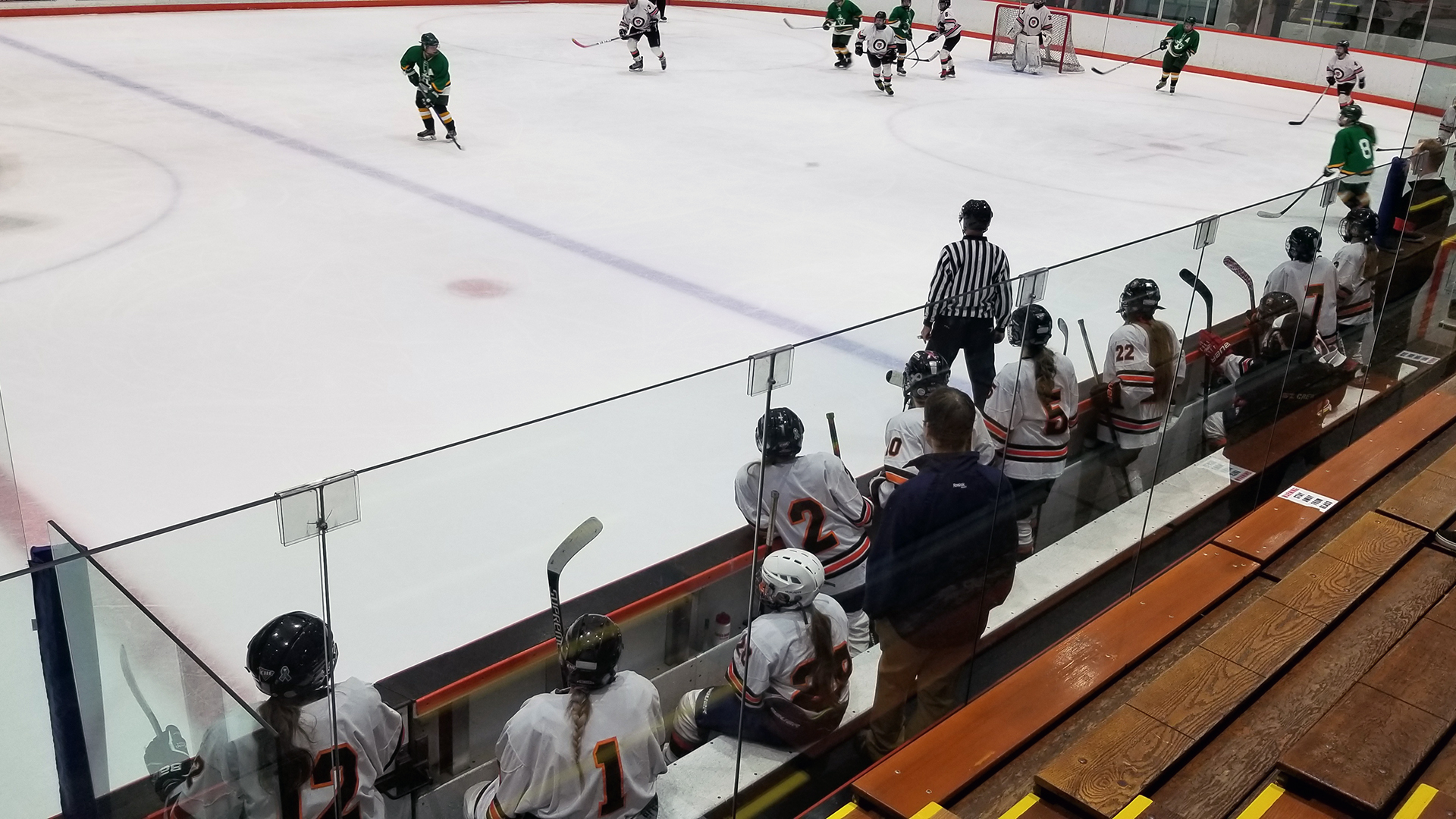Connecticut Whale at Buffalo Beauts
Northtown Center at Amherst
Williamsville, NY
October 19, 2019

Maddie Norton sat at a long table in the rink lobby, along with her teammates, in her number 16 Buffalo Beauts jersey, signing any souvenir pushed in front of her – pennants and shirts mostly, with the occasional hat or puck thrown in. As the NWHL’s standard postgame autograph line inched its way past her, it’s unlikely that many realized that Norton’s powder blue jersey, the primary thing that identified her as one of their heroes and worthy of scribbling on a $30 piece of merchandise, has not actually been used in any of the Beauts’ games to this point.
As far as Norton remembers, nobody’s said “nice game” to her in those lines, in my mind the worst thing that can happen in that situation, but the reality of a healthy scratch isn’t without some mild uneasiness.
“One time I was sitting in the bleachers watching our game and a little girl named Daisy, five or six years old, who I helped coach previously, came over and said to me, ‘Hi Maddie, your team is playing really good,’” the native Buffalonian remembered. “I kind of laughed to myself, and then replied, ‘Yeah they are!’”
“At first, I felt awkward that I was even signing autographs, but the fans don’t care, they love us all just as much. They are a great supportive community of all of us, regardless of our playing time.”
Of course, navigating those situations isn’t the worst part about not playing, not playing is.
“It’s definitely different than what I’m used to,” Norton added. “In college, I went out every other shift, sometimes double-shifted if needed, power play, penalty kill, you name it. It’s frustrating not making the lineup, but it motivates me each week to come to practice and try to be better than I was the previous week. Everyone’s really talented so the bar is set high, hopefully I’ll be in the lineup soon.”
After the postgame autographs were complete, a more relaxed Norton reappeared in the rink – wearing sunglasses, but not her jersey – to take in her alma mater, the University at Buffalo, as the Bulls hosted SUNY Oswego. She certainly couldn’t be blamed for wanting to shake off the frustration of her situation by leaving and doing just about anything else, but at that point she was no longer a healthy scratch, she was the best player in program history, triumphantly returning to overlook her queendom. After five College Hockey East regular season or playoff titles, four nationals appearances, 208 points, a pair of first-team All-American honors, and the 2018-19 Zoë Harris Award, Norton has certainly earned that much.
She was still sitting and watching at a rink where she wasn’t used to sitting and watching, but the energy of the situation both on and off the ice had changed dramatically.
“Going to a UB game actually leaves me with a feeling of ‘did I actually play at that level?’” Norton explained. “It’s just such different skill level and a totally different pace compared to the NWHL. It was a great time, but it really wasn’t an optimal place to be ever since I realized I wanted to take hockey seriously. I enjoy watching but not as much as I love playing.”
The atmosphere of UB game is also significantly different from that of a Beauts game. It’s almost impossible to believe that only an hour before in that same Feature Rink, Marie-Jo Pelletier snuck low on the weak side of an overtime power play and converted, following up her own shot. That goal capped a Buffalo rally from a 3-0 deficit, exploded a crowd of maybe 1000 ticket holders, and drew a very loud “REBOUND…THEY SCOOORE! M.J. PELLETIER! ON THE BACK DOOR, CHIPS IT BEHIND SHELLY!” from play-by-play guy Steve Bermel.
Just about the only noises produced by the Bulls-Lakers game were skates on the ice, sticks on the puck, communication between players and coaches and, occasionally, a whistle. A couple dozen onlookers managed to find their way in, but it was uncomfortably quiet, even by club hockey standards, sort of how I imagine one of those European soccer matches where a club is forced to play behind closed doors after a fan violence incident sounds (or doesn’t, I suppose).
I’m admittedly obsessed with the handful of ACHA alumni who have played in the NWHL, the defunct Canadian Women’s Hockey League, or, in a couple cases, overseas somewhere. The most obvious reason is that those players offer the opportunity for all of us to be counted. The opportunity to say hey, we might not be considered “real” college hockey by most people, but we’re still pretty good, even when competing with and against some of the best in the world.
Norton is just the latest in that light, but steady, stream. Unofficially (since a comprehensive record doesn’t exist) Lindenwood’s Kat Hannah and Penn State’s Andrea Lavelle were the first two, as each had a brief stint in a coincidentally-named National Women’s Hockey League, unrelated to the current outfit, in the early 2000s. When the modern NWHL started up in 2015 and nearly doubled the number of North American professional roster spots, Paige Harrington (UMass) and Hayley Williams (Robert Morris/Miami) found a home on the Buffalo Beauts. Cassie Dunne (Penn State) signed with the Connecticut Whale in 2017, followed by Norton with the Beauts in 2019.
Over in the CWHL, Liberty’s Sarah Stevenson was picked 17th overall in the 2015 draft by the Toronto Furies, while Rhode Island’s Kristen Levesque and Sydney Collins went to the Boston Blades a year later. Williams crossed the border in 2016 to spend a pair of seasons in the CWHL with the Furies and Brampton Thunder, while the European ACHAers include UMass alumnae Chelsea and Raschelle Bräm, twins who have carved out a six-year run in Switzerland with SC Reinach.
That group has found some measure of success. Williams was voted to the first NWHL All-Star Game in 2016, scoring a goal in the contest. Harrington won the Isobel Cup as a regular in Buffalo the following season. Stevenson’s selection came ahead of plenty of women who had played in the NCAA or Canada’s U-Sports. Events like the World University Games and the IIHF Women’s World Championships offer additional support, as those tournaments have afforded ACHA players the chance to compete and win against senior national teamers from countries like China, Japan, Slovenia, and even Russia.
Studies have found that the peak age for hockey players is around 27 years old. In the women’s game, that statistic is often cited when advocating for a professional league offering full-time salaries, and guaranteeing that we see the best of what the game has to offer. As a corollary, it’s also used to lament what might have been when the latest in an unfortunate string of 24-year-olds retires. But for Norton, or any ACHA player trying to compete with the best in the world, there’s an extra dimension to it.

While the NCAA has enacted rules to block recruitment until players are halfway through high school after things had crept to uncomfortably young ages, the fact remains that a ton of key decisions, assessments, and projections are being made on 16-year-olds. And 16-year-olds are not 27-year-olds. They aren’t even 20-year-olds.
“Pre-college I was a little bit of a suitcase, not that I was a bad player or no one wanted me, it was just how things worked out,” Norton said. “I bopped around [youth programs], from Regals to Bisons to Cazenovia. During high school I was all over the place about playing college hockey. Do I want to? Do I not want to? And before you know it, it was basically too late.”
“My last season before college, I tried out for the Niagara Purple Eagles and got cut. If I hadn’t got cut, I probably would have gone to an NCAA school to play hockey. I had received offers to go play at Cortland and some other DIII schools, but I wasn’t really satisfied and just made the choice for UB since it was close to home and I would be debt free.”
So there you have it: Norton was financially responsible and maybe a bit indecisive, and that meant she was an ACHA player instead of an NCAA Division III player, something that probably would have helped her developmentally and given her more name credibility when walking in the NWHL door.
The potential for error in the process that stamped Norton as Not Good Enough for NCAA Hockey is massive, a fact that’s been proven repeatedly by players who are cut from NCAA teams, end up playing in the ACHA, and don’t dominate. Or the numerous times ACHA teams have taken down NCAA Division III squads, or even (a couple times) ones from Division I. There’s already overlap between each of the levels at 20. So what about at 27?
Under the current reality, we often don’t get to find out. Williams turned 29 last summer and is still going, an outlier among outliers, although it certainly hasn’t been easy – since starting college, she’s played for seven different teams (in three different countries, presently including Russia) over eight seasons. Harrington played her last NWHL game at age 24. Stevenson, despite her lofty draft status, was done in the CWHL after a single season. Dunne became a healthy scratch over the second half of her rookie year and was out of the league in 2018-19, but persisted and found her way on to the roster of the Metropolitan Riveters this season, where she takes a regular defense shift.
Even the ACHA’s biggest success stories are often found around the fringes, fighting to stay on teams and in the pros, and required to make enormous sacrifices on every front to keep going, while being ignored by the minimal publicity women’s hockey has to offer. All along the way, the uncertain status of the women’s pro game acts as a sword of Damocles for the entire situation. The #ForTheGame/PWHPA protest that led to more than 150 players boycotting the NWHL this season – and probably played some role in Norton and Dunne having spots in the league – could just as quickly be resolved and take them away, or the NHL could start its own fully-paid women’s league limited to the most elite of the elite, the Olympians and near-Olympians, and drive the NWHL out of business.
Either one of those outcomes, or any number of others, could mark the end of ACHA graduates competing in the best pro leagues available at just about any point in time.
Norton is not someone who tolerates silence. Almost immediately after noting the relative lack of a scene around the UB-Oswego affair, she enlisted the help of a couple people to connect the rink’s sound system (which, for some reason, had been completely unplugged even though the Beauts had just used it for their game), casually started spinning music during stoppages, and even took a couple cracks at making public address announcements. When UB’s Hannah Latour was whistled for a couple penalties in succession, her old teammate was sure to lean down towards the boxes and offer a couple light chirps. Wherever she is, and whatever her role entails, she’s someone who’s meant to be involved, and her current responsibility of sitting cheerleader during Beauts games is completely at odds with how she’s wired.

It’s a trait that has served her well in life to this point. NWHL founder and commissioner Dani Rylan may have coined the description “dreamer. doer.” through her Twitter profile but Norton, at minimum, should probably seek some sort of royalty arrangement on it.
“There is no typical week when you are me,” she explained. “There are two things that are consistent in my life right now: going to the gym for an hour to an hour and a half four days a week, and practicing with the Beauts two days a week. Some days I’ll work my part time job which I’ve had for five years now.”
That much might not sound exceptional in a reality where all NWHL players need a primary source of income outside of their league paycheck, but we’re not quite done yet.
Norton enjoys photography and graphic design, and has done work in both areas for UB’s men’s and women’s teams, while also producing an apparel line under the label “Top Shelf Hockey.” She hops on the ice as a coach whenever she can, and has a natural intellectual curiosity, presently including learning French. But her true passion is personal training, growing her brand, developing as an entrepreneur, and breaking into that business.
“My priority right now is focusing on growing my training business online and in person. That is what I want to do in life and that’s what’s most important right now,” she explained.
“I want to be like John Opfer, who owns Proformance Sports Training [in Buffalo]. If I can be anything like him, super knowledgeable, training the some of the best athletes in the world, and have swagger at the same time, that’s when I know I will have made it.”
The ACHA, at its core, is fueled by players with a complex spectrum of motivations. Some people treat it no differently than if they were an NCAA student-athlete and give their honest best at competing at the highest level possible while getting an education. Others will look at that group, laugh, and say “calm down, it’s just club hockey, and I’m just here to have fun,” while occasionally skating in between hockey parties. There aren’t right or wrong motivations – one of the truly glorious things about all of this is that it can be whatever you want it to be – but for me personally, I’m always looking for the ones who care. The ones who hate silence.
After all, I care. And while appreciation feels good, when I’m spending most of the night at a Pilot Travel Center and writing while fending off awkward advances from the only other person there, before trying to sleep a little bit in my car through the bitter January cold, because I only have enough money for gas to get home and not for a hotel room, what I really want is to know that there’s someone on the other side of all of that who cares just as much about excelling in their own role. Feel free to insert the locker room speech from Any Given Sunday at this point, particularly the part about the guy next to you fighting for that inch with you, or any one from an entire category of similar sports clichés, but most of them are true. When you give more, those around you want to give more too.
I’ve pushed every last one of my chips to the middle for a player or a team when I get the sense that they’re in for the full pound, and I’ve flat-out quit when that wasn’t the case. And if you’re willing to do what it takes to navigate the world of women’s professional hockey, famously low-paid and featuring innumerable other inconveniences and hardships (leading U.S. National Team veteran Kendall Coyne Schofield to go on ESPN and infamously declare that players “dread” going pro), just to keep playing this stupid game? Quod erat demonstrandum, you’re Pilot material and I’m going to follow you off the edge of the Earth.
Norton cares too. And whatever the future holds for her hockey career, that ability to draw the best out of people and make her surroundings a little better will make her a fantastic personal trainer and a success wherever life takes her.

